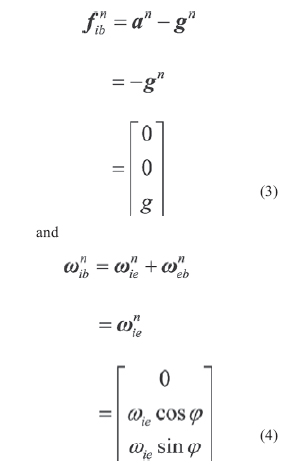| Navigation | |
A new approach for SINS stationary self-alignment
|
||||
|
The object of the SINS selfalignment is to determine the direction cosine of the transformation from the body frame to the navigation frame, namely, the elements of initial attitude matrix, using the accelerometer and gyro outputs. As the alignment accuracy affects the accuracy of the navigation system directly, one of the most important requirements of SINS alignment is high alignment accuracy. In many practical At present, the alignment model given by Bar-Itzhack and Bermant with the observations of velocity, is widely used in general stationary SINS selfalignment, such as fast alignment proposed by Jiang Cheng Fang and De Jun Wan, multipositon alignment presented by Jang Gyu Lee, Chan Gook Park and Heung Won Park, while it is not completely observable. In this model the east gyro drift rate is only weakly coupled to the velocities which would serve as external information for the purpose of alignment. So it is hard to give more attention to alignment accuracy and alignment speed during stationary self-alignment using the traditional initial alignment methods. In this paper, a new self-alignment approach based on the measurement of IMU is proposed for SINS on a stationary base. The approach needn’t to carry out SINS navigation calculation, thereby, it breaks away from the model which is not completely observable. Meanwhile, it takes full advantage of specific force and angular velocity information.which is the sensed output of IMU as well as the characteristic of SINS stationary alignment. In order to make sure the high accuracy and speed of alignment, a new alignment model which is completely observable, is established for the approach. On the other hand, for the snake of selfalignment, IMU measurement is used as observations instead of velocities. The main work of this paper is following: firstly, coarse alignment algorithm is presented. Secondly, a new fi ne alignment model for SINS stationary self-alignment is derived, and the observability of the model is analysed. Then, a modifi ed Sage-Husa adaptive Kalman fi lter is introduced to estimate the misalignment angles. Finally, some computer simulation results illustrate the effi ciency of the new approach and its advantages, such as higher alignment accuracy, shorter alignment time, more selfcontained and less calculation. Coarse alignmentNormally, SINS initial alignment process is divided into two phases, i.e., coarse alignment and fi ne alignment. The purpose of coarse alignment is to provide a fairly good initial condition for the fi ne alignment processing. For SINS stationary alignment, the carrier is fi xed to the Earth. And some characteristics of stationary alignment are conclude as follow: where g and ωie represent the magnitude of gravity and Earth rate, respectively,ϕ is the local geographical latitude. For the SINS, the accelerometer and gyro output can be expressed respectively as |
||||















 (No Ratings Yet)
(No Ratings Yet)



